We've seen a literally huge volume of interest in Sigma's camera, and it revolves around the revolutionary new Foveon X3 image sensor that the SD9 uses - which unlike the Bayer sensors in competing cameras, captures real color data for all three colors at every pixel. If you're not familiar with how image sensors work, we'd first suggest reading the Foveon X3 announcement, so that you'll know what you're looking for in our sample images and why. In a nutshell though, Foveon claims that X3-based cameras will offer better color, reduced moire, improved detail, and elimination of color moire.
Pricing was recently announced on Sigma's SD9 digital camera, and at US$1800 the 3.43 megapixel camera is only a few hundred dollars shy of 6 megapixel cameras from established brands such as Canon and Nikon. Foveon says that the 3.43 megapixel sensor will "have better color detail and are more immune to color artifacts than currently available six megapixel digital SLR cameras". Now, you can directly compare Foveon's image quality with another digital camera (Sony's $1000 5 megapixel Cyber-shot DSC-F717) directly. The comparison might be to a 5 megapixel consumer-level camera rather than the 6 megapixel digital SLRs that Foveon claims to beat, but it is still very interesting.
We have two scenes that you can directly compare between the two cameras. In both cases, the top image shows you the original scene as captured with the Sigma SD9, and identifies the cropped area with the yellow/green double line. The cropped images below show the Sony Cyber-shot at 1:1 resolution on the left, the Sigma SD9 at 1:1 resolution on the right, and the Sigma rescaled to approximately the same size as the Sony in-between. These cropped images link to the full-sized sample image from each camera in a new window. Unfortunately we don't have exact camera settings for these photos noted, but Dave recalls the settings being mostly ISO 100 at 1/250 second or higher for the outside shots, and ISO 200 at 1/80 second or so for the indoor shots. Following is Dave's thoughts on the photos:
The Sigma SD-9: Hope for Sigma in the Digital Marketplace?
Although the weather here in Cologne has been unrelentingly grey and dreary as I write this (Wednesday, Cologne time), I had a unique opportunity to snap some sample shots with a Sigma SD-9 camera with a Foveon X3 sensor chip inside it. What was really unique was that also I had the opportunity to compare a couple of shots taken with the Sigma with identical ones snapped with the Sony DSC-F717 camera (a five megapixel model using a conventional CCD sensor) I'm carrying to photograph the show. I also snapped a couple of other shots with the Sigma intended as more general examples of its performance.
SHARPNESS
While these weren't shot under the sort of controlled test conditions of my test studio, they did provide an interesting glimpse of how the Sigma camera with the Foveon chip stacked up against a camera using a conventional CCD sensor with almost twice as many pixels.
I have two shots that are direct comparisons between the two cameras, shot under identical conditions, framed as close to identically as I could manage under the circumstances. (The framing issue was complicated somewhat by the difference in aspect ratios between the two models - The Sigma has a 3:2 aspect ratio, while the Sony has a 4:3. Following standard practice established for the ISO-12233 resolution test target, I framed the two shots to produce equal angular coverage in the vertical (narrow) direction of the frame.)
The results were very interesting, at least partly supporting Foveon and Sigma's claim that the Foveon technology produces about 2x the resolution of a conventional CCD with the same number of pixels.
This was most evident in the shot I snapped of a tabletop still life with a MacBeth chart and assorted other objects. As you can see from the two images below, the Foveon rendered the details of the fine text about as well, if not slightly better than did the F717's 5-megapixel CCD. This shot was taken indoors, under strobe lighting, with both cameras set to apertures of f/8.
| Sigma SD9: Comparison 1 - Still Life |
| |
| Sony Cyber-shot DSC-F717 | Sigma SD9 (Foveon X3) |
| Original | Rescaled | Original |
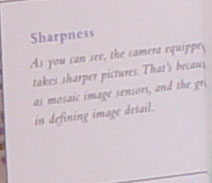 | 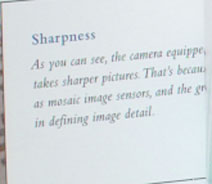 | 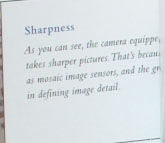 |
| (click on cropped images to see the full-sized sample image) |
| . |
The second direct comparison shot seemed to favor the F717. Cologne has a remarkable cathedral at its center, and I used it here to show an example of an object at infinity with more or less infinite detail. Here, the shot from the 717 was noticeably sharper.
| Sigma SD9: Comparison 2 - Outdoor Scene |
| |
| Sony Cyber-shot DSC-F717 | Sigma SD9 (Foveon X3) |
| Original | Rescaled | Original |
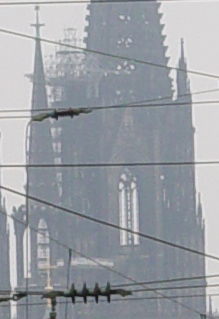 | 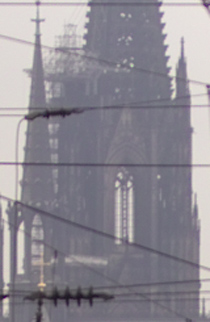 | 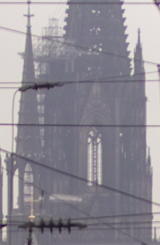 |
| (click on cropped images to see the full-sized sample image) |
| . |
I'm a little puzzled as to why the second shot showed the 717 as having more detail than the SD-9. The lens here was stopped down quite a bit, albeit not the f/8 of the strobe shot above - Hence, I'd have expected fairly great depth of field, certainly enough to catch any foreground detail the camera was focusing on, as well as the distant spire. Likewise, even though it was overcast, the outdoor light level was bright enough to produce a shutter speed well above the level at which camera shake could have produced any noticeable blurring.
If the weather clears, and time permits, I'll come back and try snapping a few more shots with the SD-9 under better conditions. The real test will await getting one in my test studio and putting it through all my usual lab tests.
What is clear from this brief experiment is that there is a very real and noticeable resolution advantage to the Foveon technology, on a pixel-for-pixel basis. Foveon had some sample images at the show, comparing identical test shots taken with the SD-9, Canon D60, Nikon D100, and Fuji S2. The comparison was marred somewhat by the fact that none of the competing cameras had had any post-capture sharpening applied to them, leaving their images well below their optimal sharpness. (This is particularly an issue with the D60, given Canon's well-known philosophy of using very minimal in-camera sharpening to preserve maximum image information.) Still, even allowing for the lack of sharpening applied to the shots from the competing cameras, the resolution provided by the Sigma was very impressive. Stay tuned for serious results, as soon as I can get my hands on a production-level test unit and run it through some proper tests.
SOFTWARE
I was also fairly impressed with the Foveon software interface for processing the raw-format files delivered by the camera. I snapped a screenshot of the main file-processing screen for you to see below, showing several of its key features. (Click on the image to see a larger view.)
| Sigma SD9: Desktop RAW software |
| |
| . |
In the upper left-hand corner of the image, you can see the window associated with the "eyedropper" color sampling tool. What's neat here is that a little window follows the tip of the eyedropper tool around, showing a 1:1 view of the image area around the eyedropper, and also displaying a readout of the RGB values under the dropper. - This is a carryover from the software for Foveon's studio camera, and is a great aid for seeing what's going on in the image.
You can't help noticing that a large portion of the sky in the photo is a glaring red. This is the "highlight warning," showing that the adjustment I made to the highlight slider in the tool panel has saturated the highlights. - This behavior can be turned on and off via the "show warnings" checkbox under the histogram display in the lower right-hand corner of the screen. (You can also set the thresholds values at which the highlight and shadow warnings appear, simply by typing the appropriate numbers into the threshold text boxes.
You'll note that there are conventional contrast and brightness sliders in the tool pane, but they're accompanied by sliders marked "Highlight" and "Shadow." I've never been a big fan of contrast & brightness controls, as they're really one or two steps removed from what a photographer will generally want to do with them. - That is, to expand or contract the image's tonal range to match that of the medium it's being reproduced in. (I generally find Photoshop's Levels controls much more useful.)
The Highlight and Shadow sliders in Foveon's software really do just what you want them to. They essentially split the tonal range in the middle, and then stretch or compress the histogram in their respective areas. That is, the highlight slider takes the right-hand side of the histogram and expands or compresses it smoothly. The shadow slider does the opposite. Very slick, much easier and more intuitive to use than to read about.
I also really liked Foveon's white balance adjustment. There's a "one click" white balance adjustment that lets you correct color casts by clicking on any neutral area of the image. (Not just a white point, you can use any shade of gray. The results of this shift are shown by way of the pastel-colored circle in the right-hand pane, with the cursor there moving to show the amount and direction of the correction. You can then fine-tune the white balance adjustment by clicking and dragging the cursor within the color circle. What's neat about this is that it makes it very easy to do a "half-cast correction," to leave enough of the original scene's color cast in the final image to subtly evoke the color of the original lighting.
There are a lot of other capabilities in Foveon's software that are obviously beyond the limits of this brief news story, but I'll close by mentioning that its "auto" capability seems both powerful and fairly brainless to use. This is very important for the Sigma SD9, because the camera doesn't generate finished JPEG files on-board, but rather requires every file to be processed on a host computer. Using the "Auto" settings greatly reduced the pain associated with this, as it was easy to just queue up a batch of files & let it rip.
Camera User Interface
I'll report fully on the SD9's user interface when I get a production unit to review, but I've included a sampling of screenshots below to give you an idea of what it looks like. The menu structure was quite efficient, as no control was more than two levels deep. For the most part, the user interface was no different than literally several hundred other cameras I've tested over the last few years, but one point stood out. While many cameras these days offer histogram displays as a way of evaluating the distribution of tonal values in your image, the SD9's histogram is tied to the pan/zoom functions in playback mode. That is, it shows you the histogram of the local area that happens to be displayed on the LCD monitor! - This lets you zoom in on any area of the image you're interested in and see exactly what's going on there. Note too, that the histogram displays separate curves for each of the RGB channels. This makes it easy to see even fairly subtle color casts in highlights and shadows.
I'd normally say at this point that I wish other manufacturers would take a page from Foveon and Sigma's books and implement the zoomed histogram display on their cameras as well. Unfortunately (well, fortunately for Foveon), they've patented this particular display wrinkle, so we're not likely to see it rippling across the digicam industry anytime soon.
| Sigma SD9: Menus and Image Review |
| |
| |
| |
| |
| |
| |
| |
| |
| |
| |
| |
| |
| . |
CONCLUSION
Well, not really - No conclusion is possible at this point, given that I've only played with a late-model prototype briefly, under far from ideal conditions. There's a lot of promise here though. If the sharpness and image quality hold up relative to the digital SLRs from Canon, Fuji, and Nikon, Sigma may well find themselves a place in the digital marketplace. I was pretty skeptical about their chances early on, but am much more sanguine having looked at files from the camera more closely. I'm not ready to announce it as a winner yet, as I really need to do more rigorous tests under controlled conditions. There does seem to be more life here than I'd expected though. Stay tuned for a full review as soon as I can get hands on a production model back in my test studio…
(A couple of) MORE SAMPLE SHOTS
The weather was truly miserable, so most of the shots I took were snapped indoors. The mixed lighting and slow shutter speeds resulted in less than ideal conditions. As noted, I'll try to get a few more shots in before I leave Cologne, but figured I'd offer up the shots below in the meantime, for those interested…
| Sigma SD9: Scene 3 - Indoor Photo |
| |
| Sigma SD9: Scene 4 - Indoor Photo |
| |
| . |
Finished with our samples, and still want more? We'd suggest taking a look at the Digital Photography Review website, which also has a number of Sigma SD9 samples...
All text and images in this article are Copyright © 2002, The Imaging Resource, and may not be republished without prior permission.